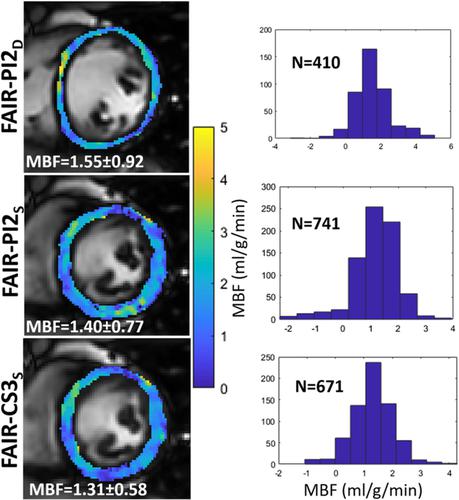当前位置:
X-MOL 学术
›
NMR Biomed.
›
论文详情
Our official English website, www.x-mol.net, welcomes your
feedback! (Note: you will need to create a separate account there.)
Myocardial arterial spin labeling in systole and diastole using flow‐sensitive alternating inversion recovery with parallel imaging and compressed sensing
NMR in Biomedicine ( IF 2.7 ) Pub Date : 2020-11-04 , DOI: 10.1002/nbm.4436 Markus Henningsson 1, 2, 3 , Carl-Johan Carlhäll 1, 2, 4 , Johan Kihlberg 2, 5
NMR in Biomedicine ( IF 2.7 ) Pub Date : 2020-11-04 , DOI: 10.1002/nbm.4436 Markus Henningsson 1, 2, 3 , Carl-Johan Carlhäll 1, 2, 4 , Johan Kihlberg 2, 5
Affiliation

|
Quantitative myocardial perfusion can be achieved without contrast agents using flow‐sensitive alternating inversion recovery (FAIR) arterial spin labeling. However, FAIR has an intrinsically low sensitivity, which may be improved by mitigating the effects of physiological noise or by increasing the area of artifact‐free myocardium. The aim of this study was to investigate if systolic FAIR may increase the amount of analyzable myocardium compared with diastolic FAIR and its effect on physiological noise. Furthermore, we compare parallel imaging acceleration with a factor of 2 with compressed sensing acceleration with a factor of 3 for systolic FAIR. Twelve healthy subjects were scanned during rest on a 3 T scanner using diastolic FAIR with parallel imaging factor 2 (FAIR‐PI2D), systolic FAIR with the same acceleration (FAIR‐PI2S) and systolic FAIR with compressed sensing factor 3 (FAIR‐CS3S). The number of analyzable pixels in the myocardium, temporal signal‐to‐noise ratio (TSNR) and mean myocardial blood flow (MBF) were calculated for all methods. The number of analyzable pixels using FAIR‐CS3S (663 ± 55) and FAIR‐PI2S (671 ± 58) was significantly higher than for FAIR‐PI2D (507 ± 82; P = .001 for both), while there was no significant difference between FAIR‐PI2S and FAIR‐CS3S. The mean TSNR of the midventricular slice for FAIR‐PI2D was 11.4 ± 3.9, similar to that of FAIR‐CS3S, which was 11.0 ± 3.3, both considerably higher than for FAIR‐PI2S, which was 8.4 ± 3.1 (P < .05 for both). Mean MBF was similar for all three methods. The use of compressed sensing accelerated systolic FAIR benefits from an increased number of analyzable myocardial pixels compared with diastolic FAIR without suffering from a TSNR penalty, unlike systolic FAIR with parallel imaging acceleration.
中文翻译:

使用并行成像和压缩传感的流动敏感交替反转恢复在收缩期和舒张期心肌动脉自旋标记
使用流动敏感交替反转恢复 (FAIR) 动脉自旋标记可以在没有造影剂的情况下实现定量心肌灌注。然而,FAIR 具有内在的低敏感性,可以通过减轻生理噪声的影响或通过增加无伪影心肌的面积来改善。本研究的目的是调查与舒张期 FAIR 相比,收缩期 FAIR 是否会增加可分析心肌的数量及其对生理噪声的影响。此外,我们比较了收缩期 FAIR 的 2 倍并行成像加速度与 3 倍压缩传感加速度。12 名健康受试者在休息期间在 3 T 扫描仪上使用具有平行成像因子 2(FAIR-PI2 D)、具有相同加速度的收缩期 FAIR (FAIR-PI2 S ) 和具有压缩传感因子 3 的收缩期 FAIR (FAIR-CS3 S )。计算所有方法的心肌中可分析像素数、时间信噪比 (TSNR) 和平均心肌血流量 (MBF)。使用 FAIR-CS3 S (663 ± 55) 和 FAIR-PI2 S (671 ± 58) 可分析的像素数量显着高于 FAIR-PI2 D (507 ± 82; P = .001),而有FAIR-PI2 S和 FAIR-CS3 S之间没有显着差异。FAIR-PI2 D的心室中层切片的平均 TSNR 为11.4 ± 3.9,与 FAIR-CS3 相似S为 11.0 ± 3.3,均显着高于 FAIR-PI2 S的 8.4 ± 3.1(两者P < .05)。所有三种方法的平均 MBF 相似。与舒张期 FAIR 相比,压缩传感加速收缩期 FAIR 的使用受益于可分析心肌像素数量的增加,而不会遭受 TSNR 损失,这与具有并行成像加速的收缩期 FAIR 不同。
更新日期:2021-01-04
中文翻译:

使用并行成像和压缩传感的流动敏感交替反转恢复在收缩期和舒张期心肌动脉自旋标记
使用流动敏感交替反转恢复 (FAIR) 动脉自旋标记可以在没有造影剂的情况下实现定量心肌灌注。然而,FAIR 具有内在的低敏感性,可以通过减轻生理噪声的影响或通过增加无伪影心肌的面积来改善。本研究的目的是调查与舒张期 FAIR 相比,收缩期 FAIR 是否会增加可分析心肌的数量及其对生理噪声的影响。此外,我们比较了收缩期 FAIR 的 2 倍并行成像加速度与 3 倍压缩传感加速度。12 名健康受试者在休息期间在 3 T 扫描仪上使用具有平行成像因子 2(FAIR-PI2 D)、具有相同加速度的收缩期 FAIR (FAIR-PI2 S ) 和具有压缩传感因子 3 的收缩期 FAIR (FAIR-CS3 S )。计算所有方法的心肌中可分析像素数、时间信噪比 (TSNR) 和平均心肌血流量 (MBF)。使用 FAIR-CS3 S (663 ± 55) 和 FAIR-PI2 S (671 ± 58) 可分析的像素数量显着高于 FAIR-PI2 D (507 ± 82; P = .001),而有FAIR-PI2 S和 FAIR-CS3 S之间没有显着差异。FAIR-PI2 D的心室中层切片的平均 TSNR 为11.4 ± 3.9,与 FAIR-CS3 相似S为 11.0 ± 3.3,均显着高于 FAIR-PI2 S的 8.4 ± 3.1(两者P < .05)。所有三种方法的平均 MBF 相似。与舒张期 FAIR 相比,压缩传感加速收缩期 FAIR 的使用受益于可分析心肌像素数量的增加,而不会遭受 TSNR 损失,这与具有并行成像加速的收缩期 FAIR 不同。











































 京公网安备 11010802027423号
京公网安备 11010802027423号